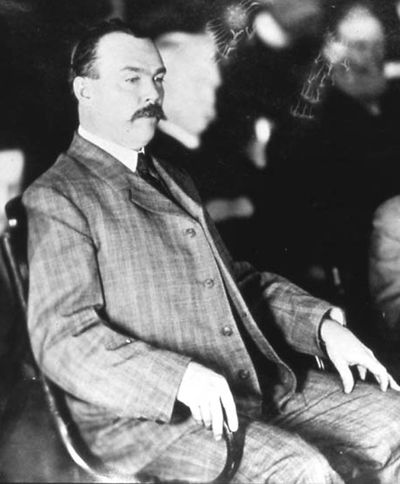Assassin left behind wife, infant daughter

CALDWELL, Idaho – Harry Orchard’s bomb, set on a garden gate in Caldwell in 1905, killed former Idaho Gov. Frank Steunenberg.
Orchard’s confession, his claim that he assassinated Steunenberg on orders from union boss “Big Bill” Haywood and Haywood’s subsequent trial are by now Idaho lore. So, too, the colorful stories of a grandfatherly Orchard spending his last days raising poultry at the Idaho State Penitentiary.
The tales have been the subject of books and “Assassination: Idaho’s Trial of the Century,” the Idaho Public Television docudrama released on the 100th anniversary of the trial. But none has ever chronicled Florence and Olive, the wife and infant daughter Orchard abandoned in Canada before embarking on his violent path in the U.S.
College of Idaho archivist Jan Boles’ new publication, “A Public Silence Broken: The Murderer Harry Orchard’s Forgotten Family,” tells that story. The 24-page booklet is available for free online.
The publication will join the historical documents Boles oversees at the College of Idaho, including papers related to Steunenberg’s term as governor.
“All of a sudden having Orchard’s family dropped into the mix, that they’ve decided they need to be part of this story, amazes me and pleases me,” said historian Judy Austin, who edited Boles’ piece and contributed research to the IPTV docudrama. Boles played a juror on that program.
Boles’ involvement with Orchard’s descendants – who wish to remain anonymous even a century after the crime – contains elements that would not be out of place in a mystery novel.
IPTV has a website where people can buy DVDs of “Assassination.” A man bought one in 2010, leaving an anonymous comment online about how he wished people knew the other side of the story and what it’s like to be a descendent of a murderer. Boles and others involved with the production were intrigued. They wrote back to the man. They got no response. Boles kept writing.
“I tried to make the case that I was a disinterested historian without an ax to grind,” he said.
Boles’ persistence paid off. The man, who turned out to be Orchard’s great-grandson, finally wrote back. He connected Boles with his mother, Orchard’s granddaughter, who is now in her mid-80s and living in Salt Lake City.
It wasn’t long before Boles found himself on the road to Utah, recording devices and document scanners in hand.
“I drove down there. It was about a six-hour drive,” he said. “There was this big question mark in my mind the whole time, was this real? But when I saw all the photographs and documents laid out, all of that was dispelled. It became a matter of trying to gather my wits and ask the right questions.”
Many of the documents and family photos are included in Boles’ new publication.
Boles’ piece relates the family’s struggles and the secrets they kept about their infamous relative. Orchard’s desertion left Florence and Olive penniless. They moved in with Florence’s father. Florence never remarried.
Orchard’s granddaughter in Salt Lake said the subject of Orchard was taboo in the family. She and her siblings learned the full story of his crimes in increments and by accident through newspaper clippings and an obituary.
Olive was known for having a sad and melancholy character throughout her life. Though she never talked about her father, she apparently knew his story. She wrote to the warden at the Idaho penitentiary in 1952 to ask if Orchard was still alive. She wanted to know for “family record purposes only,” she wrote.
“If he is still in the penitentiary, I would appreciate it if no mention was made of this letter.”
The warden wrote back that Orchard was indeed alive, “getting very old,” but “hale and hearty for a man of his age.”
Olive never met her father. He died in 1954.